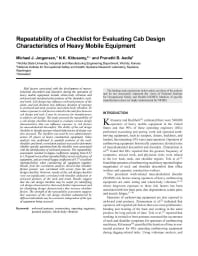Mining Publication: Repeatability of a Checklist for Evaluation Cab Design Characteristics of Heavy Mobile Equipment
Original creation date: December 2007
Authors: MJ Jorgensen, NK Kittusamy, PB Aedia
NIOSHTIC2 Number: 20032927
J Occup Environ Hyg 2007 Dec; 4 (12):913-922
Risk factors associated with the development of musculoskeletal discomfort and disorders during the operation of heavy mobile equipment include whole-body vibration and awkward and sustained joint postures of the shoulders, neck, and trunk. Cab design may influence awkward postures of the joints, and task duration may influence duration of exposure to awkward and static postures and whole-body vibration. To reduce exposure to risk factors related to the interface between cab design and task, it may be necessary for manufacturers to address cab design. This study assessed the repeatability of a cab design checklist developed to evaluate various design characteristics that can influence exposure to risk factors for musculoskeletal discomfort. The ability of the cab design checklist to identify posture-related deficiencies of design was also assessed. The checklist was used by two administrators across 10 pieces of heavy construction equipment. Video analysis was performed to quantify postures of the neck, shoulder, and trunk; correlation analysis was used to determine whether specific questions from the checklist were associated with the identification of awkward postures. The repeatability assessment resulted in kappa coefficients ranging from 0.52 to 1.0 (good-to-excellent reproducibility) across each piece of equipment, and an overall kappa coefficient of 0.77 (excellent reproducibility) when considering all equipment together. Results from the correlation analysis showed that shoulder flexion posture was correlated with scores from the cab design checklist. However, results of the cab design checklist were not significantly correlated with shoulder abduction or awkward postures of the neck and trunk. Results suggest that the cab design checklist may be useful for identifying cab design characteristics that need further improvement and for identifying design characteristics that increase shoulder flexion. The strength of the repeatability assessment suggests that outcomes of the cab design checklist administered by different individuals may be consistent, independent of the type of equipment being assessed.

NIOSHTIC2 Number: 20032927
J Occup Environ Hyg 2007 Dec; 4 (12):913-922
- A Case Study of Roof Bolting Tasks to Identify Cumulative Trauma Exposure
- A Checklist for Evaluating Cab Design of Construction Equipment
- Directional Control-Response Compatibility Relationships Assessed by Physical Simulation of an Underground Bolting Machine
- Experiments on Personal Equipment for Low Seam Coal Miners: IV. Incorporating Coiled Cord Into Cap Lamp Battery Cords
- Musculoskeletal Symptoms Among Operators of Heavy Mobile Equipment
- Practical Application of a Partial Cab to Reduce the A-Weighted Sound Level at the Operator's Station on Surface Drill Rigs
- Practical Risk Assessment Guidelines for Identifying, Assessing, and Mitigating Stored Energy Hazards in Underground Coal Mines During and After a Mine Emergency
- Self-Reported Musculoskeletal Symptoms Among Operators of Heavy Construction Equipment
- Task Analysis
- Toward a Typology of Dynamic and Hazardous Work Environments